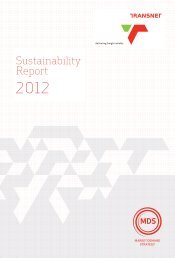Noise and Vibration Report - Transnet
Noise and Vibration Report - Transnet
Noise and Vibration Report - Transnet
- No tags were found...
You also want an ePaper? Increase the reach of your titles
YUMPU automatically turns print PDFs into web optimized ePapers that Google loves.
ENVIRO-ACOUSTIC RESEARCHSCOPING NOISE REPORT – TRANSNET: SWAZI RAIL LINK – DAVEL YARD TO NERSTON RSA ROUTE4.2.1.1 Train movementRail traffic is considered as a line source of noise with a continuous area of impact bothsides of <strong>and</strong> parallel to the railway line. Railway related noise is general acousticallycharacterised by high noise levels of relatively short duration. The wayside noise radiatedinto a community is the function of a number of different factors, namely:• interaction of wheels <strong>and</strong> rails;• the vehicle or locomotive propulsion system;• type of locomotive <strong>and</strong> wagons;• braking technology employed on the wagons <strong>and</strong> locomotives;• railway alignment, in particular the design radius of curves <strong>and</strong> turns;• auxiliary equipment;• noise radiated from vibrating structures;• train speed;• train length;• aerodynamics (for high speed operations);• locomotive warning devise or horn noise.Train speed is a major influence parameter for noise emission. The noise due to traction<strong>and</strong> auxiliary systems (diesel units, electrically driven powertrains, cooling equipment,compressors), if present, tends to be predominant at low speeds, up to around 60 km/h.Wheel-rail rolling noise is dominant up to speeds around 200-300 km/h, after whichaerodynamic noise takes over as dominant factor. The transition speeds from tractionnoise to rolling noise <strong>and</strong> from rolling noise to aerodynamics noise depend entirely on therelative strength of these sources. The rolling noise, for example, depends strongly onthe surface condition (roughness) of wheels <strong>and</strong> rails, whereas aerodynamic noisedepends on the streamlining of the vehicle. The relationship with speed is illustrated inFigure 4-1.P a g e | 25
















